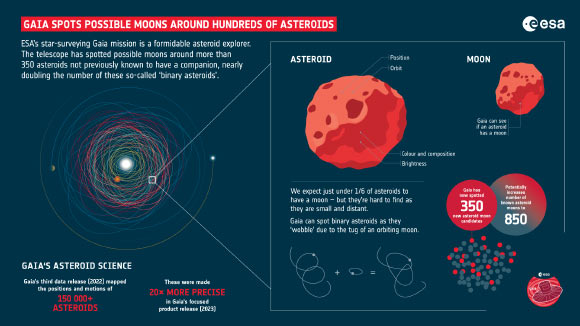Binary asteroids have attracted the attention of the scientific community due to their interesting properties and the significant impact they have on our understanding of the Solar System. Unlike single asteroids, binary systems offer unique insights into many fundamental processes, including the formation and evolution of planetary bodies, collision dynamics, and gravitational interactions.
Asteroids are fascinating objects, and hold unique insights into the formation and evolution of the Solar System.
Binaries are even more exciting, enabling astronomers to study how different bodies form, collide and interact in space.
Thanks to its unique all-sky scanning capabilities, ESA’s Gaia satellite has made a number of important asteroid discoveries since its launch in 2013.
In its data release 3, Gaia precisely pinpointed the positions and motions of over 150,000 asteroids — so precisely that scientists could dig deeper and hunt for asteroids displaying the characteristic ‘wobble’ caused by the tug of an orbiting companion.
Gaia also gathered data on asteroid chemistry, compiling the largest ever collection of asteroid reflectance spectra (light curves that reveal an object’s color and composition).
Over 150,000 orbits determined in Gaia’s data release 3 were refined and made 20 times more precise as part of the mission’s Focused Product Release last year.
Even more asteroid orbits are anticipated as part of Gaia’s forthcoming data release 4 (expected not before mid-2026).
“Binary asteroids are difficult to find as they are mostly so small and far away from us,” said Dr. Luana Liberato, an astronomer at Observatoire de la Côte d’Azur.
“Despite us expecting just under one-sixth of asteroids to have a companion, so far we have only found 500 of the million known asteroids to be in binary systems.”
“But this discovery shows that there are many asteroid moons out there just waiting to be found.”
“If confirmed, this new finding adds 352 more binary candidates to the tally, nearly doubling the known number of asteroids with moons.”
“Gaia has proven to be an outstanding asteroid explorer, and is hard at work revealing the secrets of the cosmos both within and beyond the Solar System,” said Dr. Timo Prusti, project scientist for Gaia at ESA.
“This finding highlights how each Gaia data release is a major step up in data quality, and demonstrates the amazing new science made possible by the mission.”
A paper describing the results was published in the journal Astronomy & Astrophysics.
_____
L. Liberato et al. 2024. Binary asteroid candidates in Gaia DR3 astrometry. A&A 688, A50; doi: 10.1051/0004-6361/202349122
This article was adapted from an original release by ESA.

